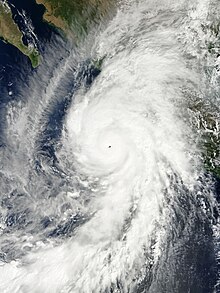Pressure-wind relationship calculations for tropical cyclones

There are several different methods to derive pressure from wind speed and vice versa in tropical cyclones. Both information minimum pressure and wind speed have their utilities. Wind speed can describe the destructive potential of a tropical cyclone.[1]
Method
[edit]According to Christopher Burt from Weather Underground, the most reliable method of estimating pressure from wind involves using the Dvorak Technique with an infrared image, which shows how cold cloud tops are.[2] Joe Courtney and John Knaff noted that as several models are based on Atlantic data, it can lead to biases in other parts of the world.[3]
Most pressure-wind models are in the form of:[4]
Where vm is the maximum wind, Δp is the change in pressure from an external point to the center. a and x are constants.[4] Ted Fujita was the first to modify the exponent; before then, it mostly stood at 0.5.[4]
Models
[edit]Knaff-Zehr
[edit]Knaff and Zehr (2007) came up with the following formula to relate wind and pressure, taking into account movement, size, and latitude:[5]
Where Vsrm is the max wind speed corrected for storm speed, phi is the latitude, and S is the size parameter.[5] S is more specifically defined as the ratio of tangential wind at a radius of 500 kilometres (310 mi) to its value under a Rankine vortex model.[6]
Holland
[edit]In 2008, Greg Holland published his model to the Monthly Weather Review.[4]
Usage
[edit]The interchangeability of pressure and wind allows for the two to be used to give equivalencies for the public.[7] Pressure-wind relations can be used when information is incomplete, forcing forecasters to rely on the Dvorak Technique.[6]
Some storms may have particularly high or low pressures that do not match with their wind speed. For example, Hurricane Sandy had a lower pressure than expected with its associated wind speed.[7]
See also
[edit]References
[edit]- ^ Knaff, John A.; Zehr, Raymond M. (February 1, 2007). "Reexamination of Tropical Cyclone Wind–Pressure Relationships". American Meteorological Society. 22 (1): 71–88. doi:10.1175/WAF965.1. ISSN 1520-0434.
- ^ Burt, Christopher C. (November 2, 2017). "Possible New World Record for Lowest Barometric Pressure: 860 mb?". Weather Underground. Retrieved December 22, 2024.
- ^ Courtney, Joe; Knaff, John A. (November 3, 2009). "Adapting the Knaff and Zehr wind-pressure relationship for operational use in Tropical Cyclone Warning Centres" (PDF). Australian Meteorological and Oceanographical Journal (58) – via ResearchGate.
- ^ a b c d Holland, Greg (September 1, 2008). "A Revised Hurricane Pressure–Wind Model". Monthly Weather Review. 136 (9): 3432–3445. doi:10.1175/2008MWR2395.1. ISSN 1520-0493.
- ^ a b Holland, Greg (2017). "Global Guide to Tropical Cyclone Forecasting: Chapter Eleven" (PDF). World Meteorological Organization. Retrieved December 28, 2024.
- ^ a b Kieu, Chanh Q.; Chen, Hua; Zhang, Da-Lin (2010). "An Examination of the Pressure–Wind Relationship for Intense Tropical Cyclones" (PDF). Weather and Forecasting – via University of Maryland Department of Atmospheric and Oceanic Science.
- ^ a b Chavas, Daniel R.; Reed, Kevin A.; Knaff, John A. (November 8, 2017). "Physical understanding of the tropical cyclone wind-pressure relationship". Nature Communications. 8 (1): 1360. doi:10.1038/s41467-017-01546-9. ISSN 2041-1723. PMC 5678138.


